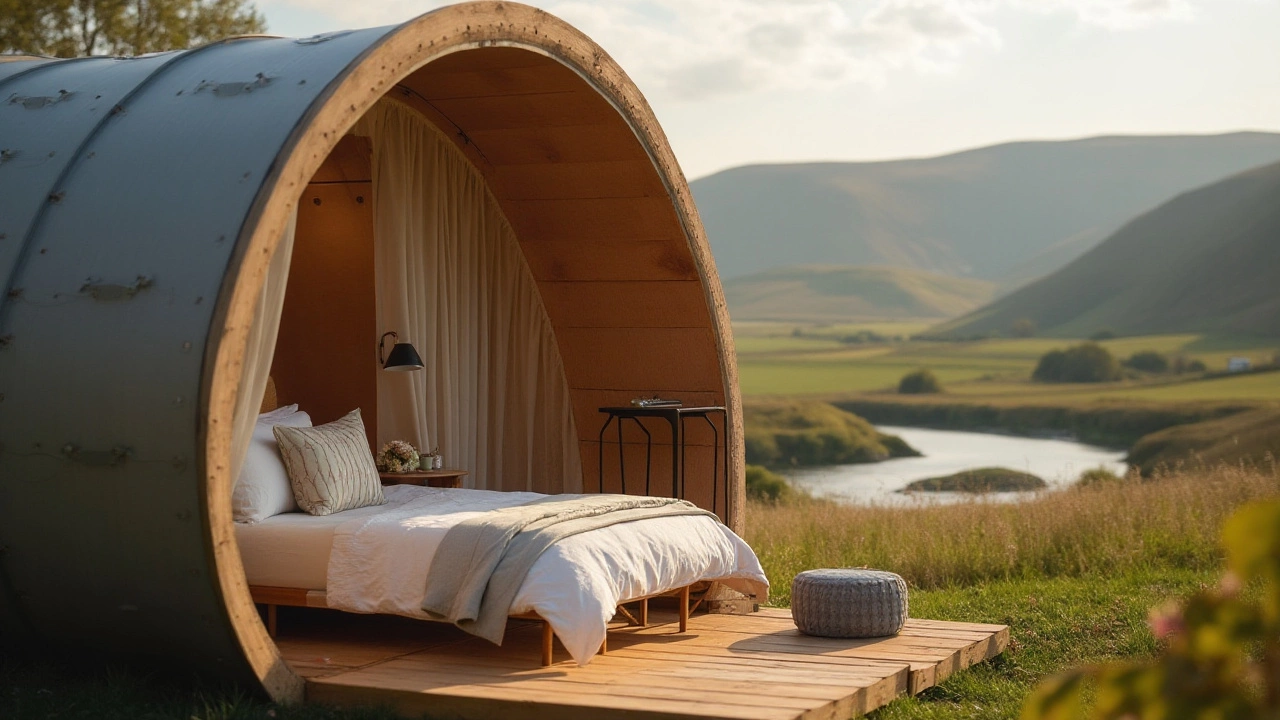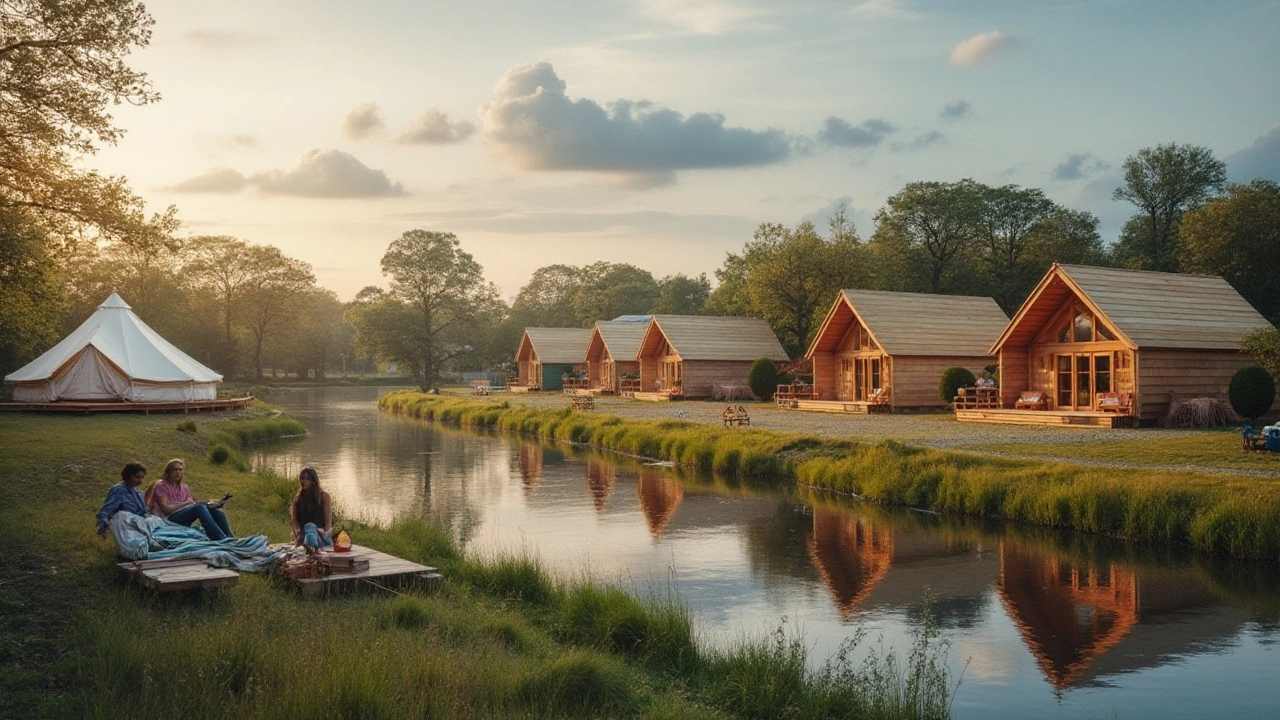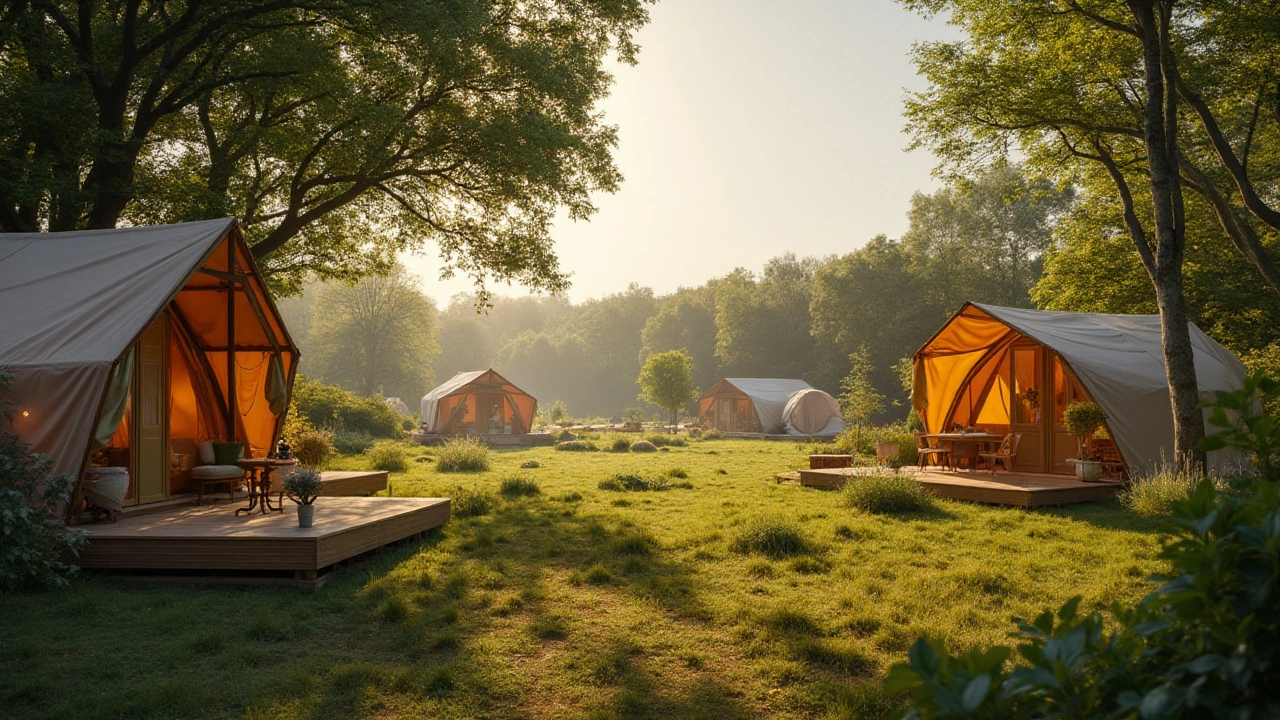In recent years, glamping has soared in popularity, attracting adventure seekers who crave nature without giving up comfort. But what does it actually cost to construct a glamping structure? From minimalist designs that harmonize with nature to extravagant cottages that rival five-star hotel suites, the price tag can vary greatly depending on multiple factors. This article provides a holistic view of the elements that play into the cost of glamping structures, assisting you in making informed decisions. Let's embark on this journey to discover the intriguing world of glamping costs.
- Types of Glamping Structures
- Factors Influencing Costs
- Benefits of Investing in Glamping
- Budgeting for Glamping
- Hidden Costs and Maintenance
Types of Glamping Structures
When it comes to glamping, the variety of structures available caters to a wide range of desires and budgets. One of the most iconic and traditional choices is the yurt. Originating from Central Asia, yurts offer an eclectic mix of cultural history and modern comfort. Their sturdy build from canvas and wooden frames makes them reliable in various weather conditions, while the circular design provides an inviting communal space. Glamping enthusiasts often choose yurts because they can easily be equipped with amenities like wood-burning stoves, plush bedding, and even basic kitchen facilities. Their cost can vary, but a simple yurt might start at around a few thousand dollars, while a fully furnished version could set you back considerably more.
Another popular option in the world of glamping is the safari tent. Known for their spaciousness and upscale camp-like feel, safari tents bring a bit of exotic adventure to the camping experience. They are often used in luxury glamping resorts due to their ability to provide both openness to nature and a sense of safety. Featuring high ceilings, wooden floors, and the capability to partition spaces, they are perfect for families or larger groups. These tents can be quite the investment, often ranging from several thousand dollars to tens of thousands, especially when adorned with full furnishings and amenities.
On the other end of the spectrum are geodesic domes, which have recently become a hit in the glamping community for their futuristic look and environmentally friendly design. These structures boast excellent insulation and resistance to strong winds. With panoramic windows, a stay in a geodesic dome offers some of the best views of the surrounding landscapes, particularly appealing in areas known for their stunning vistas. The cost for setting up a dome can widely fluctuate depending on size and interior finish, generally starting from a more modest price point but quickly climbing as luxuries are added.
Treehouses, a whimsical choice for those wanting to relive childhood fantasies, have also found their place in the glamping scene. Constructing a treehouse requires not only an affinity for design but also a careful consideration of the environment and the trees themselves. Though they offer an exhilarating escape into nature, treehouses can be expensive due to the engineering and design work required. They can range from simple platforms to elaborate hideaways featuring multiple rooms, often costing a substantial amount of money to build and maintain.
For those with a nautical appreciation, airstreams and vintage trailers have become darlings in the glamping world. These mobile marvels combine the adventure of road trips with the charm of retro aesthetics. Restored with a modern twist, many trailers today come fitted with chic interiors and technology that cater to all the modern conveniences expected by glampers. The price for such luxury on wheels can be higher due to restoration costs, sometimes even surpassing those of more stationary structures.
"Glamping allows people to escape into nature without leaving behind the comfort of luxury and creativity in habitat design," says Amelia Dart, editor of the Eco Travel Magazine.
Factors Influencing Costs
Understanding the costs associated with glamping structures is akin to peeling back the layers of a complex onion. There are myriad components to consider, each contributing to the final price tag. To begin with, the type of structure you opt for plays a pivotal role. Whether you're drawn to the quaint allure of cottages or the contemporary vibes of yurts and pods, each option brings a unique set of materials and construction requirements. For instance, a canvas tent might carry a modest cost, while a geodesic dome constructed with durable, weather-resistant materials could see the price significantly increase. In many cases, the choice of material influences not only the budget but also the lifespan and comfort of the structure, pushing potential glampers to weigh their options carefully.
"The rise of experiential travel has made glamping an appealing option for eco-conscious tourists," says Edward Jackson, a well-respected travel consultant with over two decades of experience.
Geography also plays a crucial role in determining costs. Building in remote locations, which often embody the spirit of glamping, typically incurs higher expenses due to logistical challenges. Transporting materials to secluded areas can be costly, not to mention the skilled labor required to construct these often unconventional dwellings. While some might save on land costs by choosing private property, this is counterbalanced by the expense of making the location accessible and ensuring it has the necessary amenities like water and power. On the other hand, opting for a more mainstream location can reduce logistical costs but may come with higher land prices.
Speaking of amenities, what you include—or omit—in your glamping experience directly influences the bottom line. Some structures might offer only basic amenities, designed to provide a rustic escape. Others cater to luxury, complete with electricity, plumbing, and even air conditioning. The inclusion of such features dramatically influences both the construction costs and the ongoing operational budget. For example, installing a small kitchen and bathroom can more than double the cost of your base unit, but it might also enhance the comfort and appeal of the experience, potentially justifying a higher room rate for future glampers. Ultimately, balancing these desirables with your budget is key to creating a sustainable and attractive glamping site.

Benefits of Investing in Glamping
Investing in glamping has become an increasingly attractive opportunity for those with a taste for entrepreneurial endeavors, as well as for seasoned investors looking to diversify their portfolios. In a world where experiential tourism is on the rise, providing travelers with unique and memorable stays is not just a niche market, but a rapidly growing sector. Glamping combines the desire for outdoor experiences with the comforts of modern amenities, offering a high-value product that travelers are willing to pay a premium for. This translates into potentially high returns for investors who choose to tap into this innovative accommodation trend. From elevated tents that offer awe-inspiring panoramic views to eco-friendly cottages that seamlessly blend into their natural surroundings, the options are plentiful and the potential for satisfaction is immense.
One of the noticeable advantages of glamping structures is their versatility and adaptability to different environments. Unlike traditional hotels or resorts, which require significant alterations to the landscape and often face zoning or regulatory challenges, glamping structures can be erected with minimal environmental impact, retaining the natural beauty of the location. This aligns perfectly with the growing global commitment to sustainable tourism and environmental conservation. Eco-conscious travelers are seeking out destinations that practice sustainability, providing glamping sites with an edge in the tourism market.
Moreover, the setup cost for a glamping structure is often significantly lower than building conventional lodging facilities. Traditional hotel construction involves enormous expenditures from materials to labor, whereas a well-designed glamping setup can be assembled with fewer resources. This lower cost of entry allows investors of different scales to enter the market. Once operational, glamping sites can also generate substantial revenue. A survey conducted by a leading tourism organization revealed that the average nightly rate for glamping per unit often matches or exceeds that of hotel rooms in the same area. Glamping sites have reported occupancy rates that tend to be higher, especially in picturesque or remote locations, ensuring steady cash flow.
It's also worth noting that glamping appeals to a diverse demographic. From families with young children seeking a safe yet adventurous vacation, to individuals and couples desiring solitude or rekindling romance under the stars, the diversity of the audience is vast. This broad appeal helps ensure that the market for glamping remains robust and less susceptible to declines compared to traditional tourism that might target narrower demographics. Given these advantages, it's clear why many investors are making the strategic decision to invest in glamping. If you're considering joining this thriving industry, it's certainly a dynamic and promising avenue worth exploring.
Budgeting for Glamping
When dreaming of venturing into the enchanting world of glamping, one can't simply ignore the financial implications. Crafting a budget is pivotal, not just to keep you within your means, but also to ensure that every aspect of your retreat aligns with your vision of a perfect escape. As the trend of glamping continues to grow, potential glamping hosts must decide on the type of accommodation they plan to offer. Whether you are considering majestic yurts, vintage airstreams, or eco-friendly pods, each choice demands an understanding of both the initial expenses and ongoing costs.
A common misconception is that investing in glamping is akin to setting up tents at rock-bottom prices. However, the truth is quite different. Glamping structures are often crafted with the essence of uniqueness and offer home-like comforts. For those eyeing a basic bell tent, you could be looking at a spend of several hundred dollars. But if your taste veers towards opulent lodges equipped with plush beds, modern kitchens, and private hot tubs, the price tag leaps into tens of thousands. Delving deep into your finances, think beyond the glamping accommodation. Consider the cost of utilities, permits, design, and landscaping that transform the space from an empty field into a hospitable wonderland.
"An informed investment is half the battle won," suggests the Business Magazine, highlighting the importance of research and planning in setting up successful glamping sites. As with any business, market research cannot be underestimated. This ensures you are competing effectively and staying attractive to your potential clientele. Assess your target demographic, and explore what they value most in a glamping experience. Are they after a rustic retreat, or do they crave more luxurious lodgings with all the bells and whistles? Understanding these elements allows you to allocate your budget judiciously, attracting wanderlust travelers right to your doorstep.
Strategically budgeting for your site extends beyond your initial outlay. Ongoing costs like maintenance and seasonal preparation can catch unprepared hosts off guard. Hence, crafting a comprehensive financial plan that includes an allowance for unexpected repairs is vital. Maintenance goes beyond keeping the structures standing; it involves preserving guest comfort and safety standards. Elements like seasonal upgrades, such as improved insulation for winter, improve guest satisfaction and, in turn, justify higher fees during peak seasons.
Choosing quality over quantity is another budgeting philosophy worth embracing in the glamping world. Instead of stretching your budget thin over multiple lower-end accommodations, invest in a fewer number of high-impact, quality experiences. This can lead to higher satisfaction ratings and drive repeat visits. Over time, this approach often yields better financial returns and a more sustainable business model. However, never neglect local regulations and environmental factors, which can impact initial costs. Consultation with professionals or existing operators can lead to beneficial insights into cost-effective solutions and hidden pitfalls. Budgeting wisely aids in realizing your financial targets while providing guests an unforgettable slice of nature infused with luxury.

Hidden Costs and Maintenance
Unveiling the charms of nature through glamping is a captivating venture, but it often comes tethered with hidden costs that can catch the unprepared by surprise. Beyond the visible expenses of construction, there are underlying expenditures that can quietly chip away at budgets. This section aims to arm you with insights into these covert responsibilities. A surprising contributor to these hidden costs is the need for consistent and thorough upkeep. Routine maintenance is an ongoing affair, ensuring the structure withstands the elements and retains its inviting appeal. Neglect, even in the short term, can lead to costly repairs annually.
One major area that often requires foresight is waste management. In locations set away from urban convenience, establishing effective waste disposal systems isn't just a necessity, it's an obligation. Such setups often involve additional permits and fees, contributing to the hidden price of your glamping dream. Not to forget, there’s insurance—a safeguard not only for the structure itself but potentially for the contents within. Depending on the locale and structure type, policies can vary substantially in cost, making this yet another hidden treasure trove of expenses.
Maintenance also tangentially links to safety, as the need to replace weather-worn materials or ensure fire safety can punctuate the landscape with unplanned costs. Each of these areas can absorb a surprising amount of resources if not planned in advance. According to a noted industry expert,
"Maintenance is the heartbeat of glamping structures. Just like any thriving venture, you reap what you sow."This underscores the significance of regular investment in the upkeep of your glamping haven. The forgotten expense of pest control is yet another dimension many investors realize after facing crawling or burrowing invaders. In natural environments, controlling pest incursions requires season-specific strategies and sometimes, specialized treatments.
Landscaping around the adored glamping dwellings isn't merely for aesthetics. Proper landscaping can prevent soil erosion and manage water flow—both critical in maintaining the integrity of the structure. Factor in periodic inspections, the cost of replacing equipment and furnishings, and suddenly the term ‘hidden costs’ becomes all too tangible. Each piece adds to the intricate puzzle of creating experiences without the accommodations losing their luster over time. Below is a table summarizing some average costs associated with these hidden elements:
| Aspect | Average Cost (Annually) |
|---|---|
| Insurance | $1,200 - $3,000 |
| Waste Management | $500 - $1,400 |
| Pest Control | $300 - $900 |
| Regular Maintenance | $1,000 - $2,500 |
In essence, comprehending these components not only clarifies budgeting requirements but also enhances foresight in the enchanting field of glamping investments. The clarity in understanding hidden costs and diligent maintenance paves a stable path to achieving a seamless, luxurious escape surrounded by nature's tranquility.
